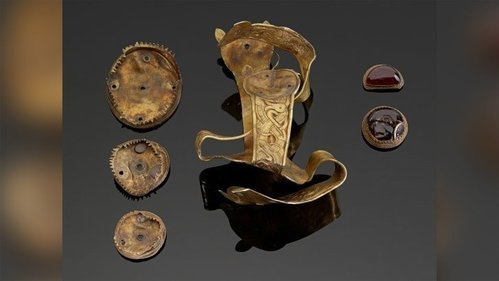New research sheds light on largest-ever Anglo-Saxon treasure hoard

A decade after the largest haul of Anglo-Saxon gold and silver was discovered in an English field, archaeologists are shedding new light on the origins of the treasure.
The collection, which was uncovered in 2009 by an amateur metal detectorist in a field in Staffordshire, England, is made up of more than 600 significant objects found in 4,600 fragments — totaling nearly 4 kilos (8.8 pounds) of gold and 1.7 kilos (3.7 pounds) of silver, according to experts working with the UK agency Historic England and local public and nonprofit entities.
Comprised of mainly war artifacts — detailed fittings stripped from swords, a gilded silver helmet and an array of battle gear — the trove was assembled between the mid-sixth and mid-seventh centuries AD and buried between 650 and 675 AD, a team of archeologists and historians found.
Following years of research by conservationists, historians and archeologists, the impressive find is now thought to include artifacts captured from kingdoms in East Anglia and Northumbria — something researchers say “offers vivid confirmation of the widespread and brutal events” between warring English kingdoms, which have been described in near-contemporary sources from the period.
In “The Staffordshire Hoard: An Anglo-Saxon Treasure,” a book released Friday, archeologists point to “convincing evidence” that precious Christian objects were carried as talismans into battle, most likely by priests.
Experts say the objects could be some of the earliest known examples of Anglo-Saxon ecclesiastical metalwork, blending traditional motifs with new Christian objects that were being adopted as the religion became established in England.
The collection of artifacts contains both Christian and pagan symbolism, and it bears influences from different times and places, experts say. As well as battle gear, an early Christian head dress and fittings in the shape of snakes, birds and horses were discovered.
Archeologists are still unsure as to why the hoard was assembled and buried in a field near what is now the village of Hammerwich, but they speculate that the treasure could have been hidden, to be retrieved later, or put into the ground as part of ritualized concealment.
“In 2009 we received a rather breathless call from an officer of the Portable Antiquities Scheme saying that something astonishing had been unearthed in an ordinary field near Lichfield. What followed exceeded all expectations and over the past 10 years we have been proud to fund the research into the Hoard that has allowed us to learn just what our 7th Century ancestors were capable of,” Duncan Wilson, chief executive of Historic England said in a statement.
“The range of fascinating objects discovered has given us an extraordinary insight into Saxon craftsmanship and culture and this new monograph gives in-depth detail of everything we know about this spectacular discovery,” he added.



